| Home | Material | My Telescopes | Mirror Making | Deep Sky | ext. Links |
| 32" Mirror | 24" Kyklopas | 17,5" Aristarchos | 14" Mirror | 10" Archimedes | 10" Travel Dobson | 24 cm Quints | 17 cm Twins | 6" Traveldobson |
| Deutsch (de)![]()
| Home | Material | My Telescopes | Mirror Making | Deep Sky | ext. Links |
| 32" Mirror | 24" Kyklopas | 17,5" Aristarchos | 14" Mirror | 10" Archimedes | 10" Travel Dobson | 24 cm Quints | 17 cm Twins | 6" Traveldobson |
Aristarchos 17.5" f/4.5
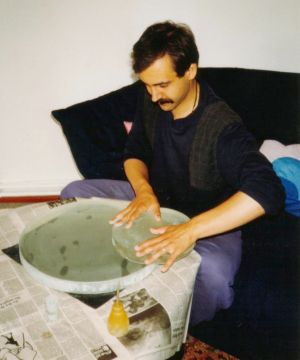 |
Mirror: I made the mirror in 1992. It was larger than I initially wanted it, but I got somehow this 17.5" Pyrex blank in my hands. It's 40 mm thick (1.6") and weights 13.3 kg (29.3 lb). At the Foucault test I determined a wavefront error peak to valley of Lambda / 7. See Test analysis (excel sheet). At the star test I rate it to 3-4 according to Bratislav's mirror rating scale. When I viewed Mars with it the first time, it blew me out of my shoes, and socks too. |
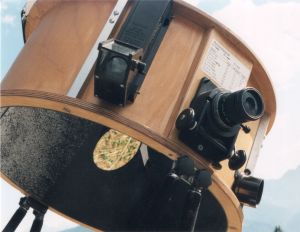
|
Secondary cage: It's lightweight and stable. Two plywood rings are connected with 15 x 15 x 2 mm ( 0.6" x 0.6" x 0.08") rectangular bars on which the spider is hung on. As a cover a 2 mm (0.08") airplane plywood sheet is glued at the rings, which provides extra stiffness to the structure. All plywood at this telescope is Baltic Birch. The inner surface is rough, to make it less reflective. The initial sock against stray light was later replaced against baffles as they provide the same effectivity, but give less wind resitance. Here another view to the top cage. |
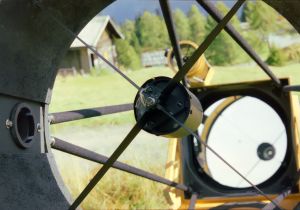 |
The diagonal mirror is held by a Novak secondary holder and spider. |
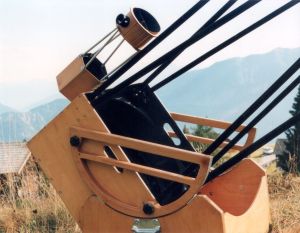 |
Mirror box: It is made of 12 mm (0.47") plywood for the bearing side panels and 9 mm (0.35") for the front and rear side. Triangular reinforcement braces into the corners reinforce the structure. The bearings are covered with a hard textured laminate with the German name "Duropal" and glide on Teflon. They are removable for transport and storage. The mirror cover sheet is placed directly above the mirror leaving storage room for the altitude bearings, finder, bolts, eyepiece case, warm socks, chocolates etc. I store the telescope like this and thus be sure, not to forget anything. |
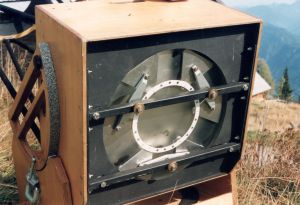
|
Mirror cell: Welded steel construction with 20 x 20 x 3 mm (0.79" x 0.79" x 0.12") rungs and 25 x 3 mm (1" x 0.12") side rails. This is so strong, it stabilizes the whole mirror box. The mirror rests on an 18- point flotation cell with 4 mm (0.16") aluminum triangles and 8 mm (0.3") connecting bars. Radial support is done with a car safety belt. No stress, no visible flex, no astigmatism! At the back side a ring baffle is inserted to prevent light leaking between mirror and box walls. The air can still circulate to cool down the mirror quite rapidly. |
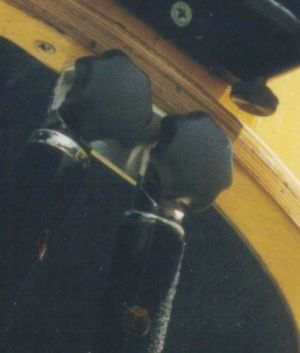 |
Trusses tubes: Design with 8 aluminum trusses Ø 20 x 1,5 mm (0.79" x 0.06"), 1.40 m (55") long, covered with black velvet laminate. Upper truss poles: A Ø 17 mm (0.67") aluminum stud with a bore to accept the M6 (0.24") bolt is epoxied into the trusses. This method is very stable and keeps collimation, but requires to screw and unscrew the 8 clamp knobs. |
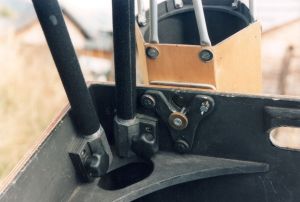 |
Lower truss connections: 8 thin walled aluminum blocks. Here only a tightening of the clamp knobs is needed, no loose parts. A friend with a lathe helped me, to make the bores of this blocks, thank you Gert. |
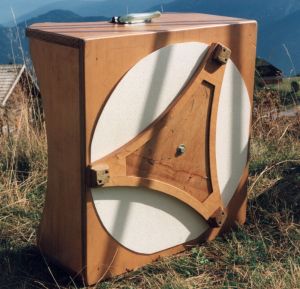 |
Rocker box: Plywood in sandwich construction to save weight. At the azimuth bearing Glasbord rides on Teflon. This combination is superior to all I tried so far. Later I discovered, that original Ebony Star from Wilsonart works very fine as well, but it was nearly impossible to get this stuff in Europe. In the following time I tried all kinds of laminates against Teflon and found out: The harder and more pebbled the surface is, the lower is the slip/stick effect (smaller difference between static and dynamic friction). This results in a more precise hand tracking control even at high magnification. |
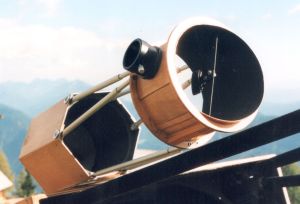
|
The 4" f/4 Newtonian finder: It weights 1 kg (2.2 lb) only and is placed adjustable near the balance point of the telescope (see detail). I hate finders with star diagonals and their confusing mirror views. This one here shows the same orientation than the main instrument and keeps your mind free from "translating" back and forth reversed views. In combination with the Telrad this thing finds everything, that can be found. I use it also quite often as as rich field telescope, or guide other people at star parties, who are not so experienced in driving a Dobsonian. The mirror is self made, of course. Secondrary holder details see at picture from the front and picture from the back. |
to top of this page
Home | Imprint | Privacy Policy | about |